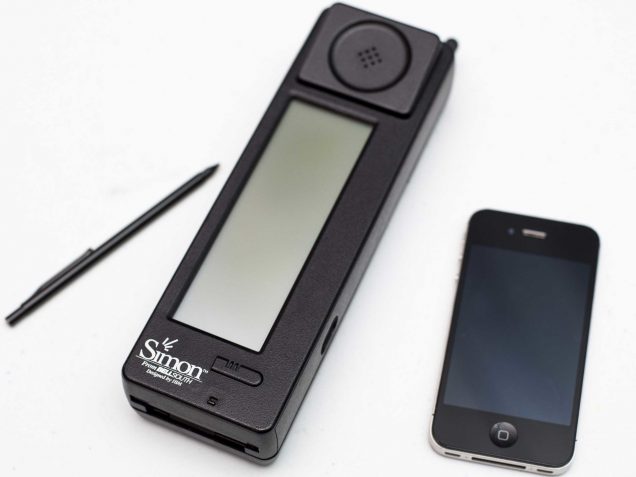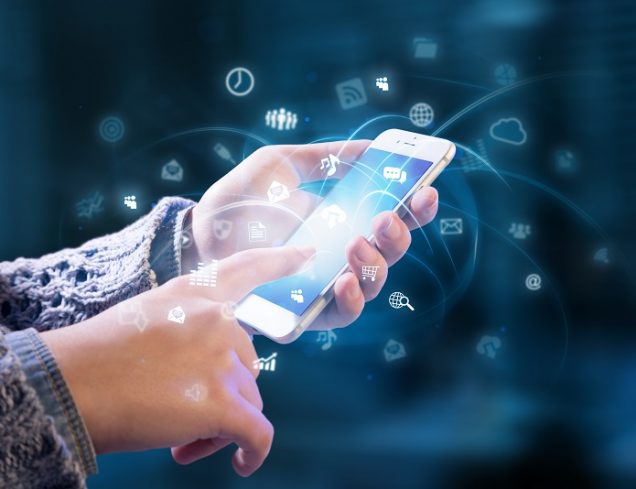“The term ‘smartphone’ did not actually exist then but few would contest that Simon was, indeed, a smart phone.” (Pothitos, 2016) Although iPhone has been dominated the smartphone industry with advanced technology since 2007, it is not the first smartphone in the world.

A prototype of the first smartphone named “Angler” was invented by Frank James Canova and exhibited at the COMDEX computer industry trade show on November 23rd, 1992 in Las Vegas, Nevada, United States. Then the final version named “Simon Personal Communicator” was developed by IBM and formally released to the market by BellSouth in 1994. “Aside from its telephony features, Simon also featured many applications and services including email, calendar, calculator, address book, world time clock, notepad, multiple on-screen keyboards, and even the ability to send and receive faxes”(Pothitos, 2016).It is more like a “mobile office” or a “life assistant”. In fact, the term “smartphone” was created in 1995, one year after the appearance of the Simon. “Even though Simon only sold 50,000 units and lasted for a mere six months on the market”(Pothitos, 2016),it can represent the progress of communicative technology and be the world-recognized first smartphone because its characteristics and features like a computer had never ever heard before that time .

Nowadays, smartphone still remains revolution and becomes more crucial for people as a basic need that equates with water and food. For example, with the increase of intelligent products, such as furniture, appliances and vehicles, smartphone will become a main multifunctional remote control to manipulate our lives. However, despite that smartphone brings plenty of conveniences to make life become easier, it is a double-edged sword. Negative effects accompany with the quick revolution of smartphone. Because the revolution of smartphone can fully satisfy or even exceed users’ demands, the smartphone addiction phenomenon become serious gradually so that it impacts capabilities and leads to negative psychological consequences. It is problematic that “the device takes over a function that human brain is capable to perform perfectly”(Sarwar & Soomro, 2013). People’s capabilities will decrease if smartphone can replace people to help them do something. Hartanto and Yang (2016) concluded several psychological consequences of smartphone dependency, such as impulsive behaviors, lack of perseverance and cognitive failures. “Since the smartphone is perceived as an extension of the self, smartphone separation induces perceived loss of self, which in turn causes anxiety”(Hartanto & Yang, 2016).Problematic smartphone use can impair people’s psychological endurance and leave negative consequences.
In addition, smartphone also has some negative social effects from a contemporary perspective. Spreading rumors and dispelling rumors are common phenomena nowadays.Smartphone becomes the main toolof networks to spread information due to its quick revolution and popularization. Although it is very useful and accelerates speed and range of spreading, the quality of information cannot be guaranteed; it is inevitable that some people will utilize advantages of this tool to spread fake information and rumors to achieve their own intrigues. As an example of Arab Spring, it was very efficient that protesters relied on electronic mediums, such as smartphones, emails and video clips, to access various social media platforms to gather more protesters, while some people chose to propagate violence and spread rumors so that the protest was disrupted and led to many negative social effects. Based on this event, the degree of government’s surveillance on spreading information becomes a determining factor of social movements security and directions. Whatever new social media, developed social media or any other online communicative tools, reliability of information needs to be further verified due to the complicated social environment. Thus, it is problematic to identify social movements or eras by communicative tools.

Personal information becomes exposed after people fully enjoy conveniences of intelligent technological products and powerful features of network. Therefore, smartphone technology is revolutionary on protecting individual privacy.In the recent one year, most smartphone added facial recognition system to promote the security of personal information and use conveniences as well as added more privacy settings to limit the accessibility of different applications. Recent popular wearable networked device is Apple Watch. According to the trend of its technological updates,wearable networked devices will almost have all features of the latest smartphone gradually.So wearable networked devices will be revolutionary to equate with or even replace smartphone.
In my opinion, the contemporary stage of online-social-mobile media revolution have many useful features and positive influences that match a very Hauberian sense, which means that the net is still open to everyone to connect publicly and it is easier for people to arrange information, share thoughts to the world or control one’ life; while the Hauberian sense is idealistic about commercial and privatized aspects.At present, personal information and browsing records are collected by social media platforms to establish database to make database commercialized and privatized. Personal privacy does not exist anymore.The nascent “hacker-geek” cultureis the most insecurity factor to network and users’ privacy, but it indeed contributed to accelerate the development of network to preventillegal invasions.
References
Pothitos, A. (2016, October 31). The History of the Smartphone. Retrieved from http://www.mobileindustryreview.com/2016/10/the-history-of-the-smartphone.html
Sarwar, M., & Soomro, T. R. (March, 2013). Impact of Smartphone’s on Society. European Journal of Scientific Research,98, 216-226. Retrieved from https://pdfs.semanticscholar.org/2c28/0b6a690442a97a571e09b2404e2d21720db4.pdf
Hartanto, A., & Yang, H. (2016). Is the smartphone a smart choice? The effect of smartphone separation on executive functions. Computers in Human Behavior,64, 329-336. doi:10.1016/j.chb.2016.07.002